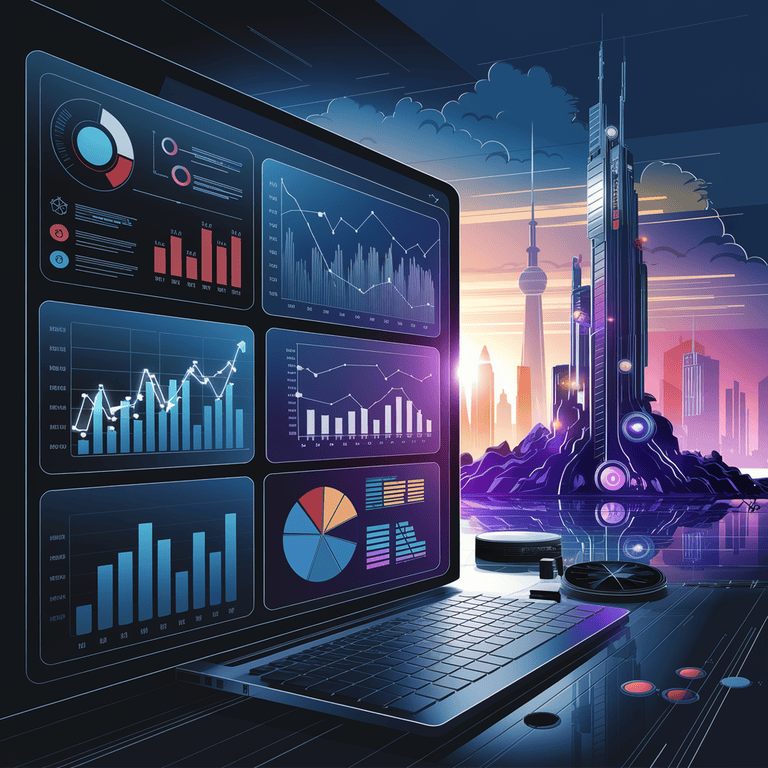AI-powered competitor analysis is the use of artificial intelligence to gather, process, and analyze competitor data. Unlike traditional research methods that rely on manual data collection and subjective interpretation, AI automates and enhances the process.

Definition and Core Concepts
Competitor analysis AI leverages machine learning, natural language processing (NLP), and data analytics to uncover insights about market trends, customer sentiment, and competitor strategies.
Key functions include:
- Automated Data Collection – AI scrapes websites, news, and social media for real-time updates.
- Pattern Recognition – Machine learning detects trends in competitor pricing, content strategies, and marketing efforts.
- Predictive Insights – AI forecasts competitor moves based on historical data.
How AI Enhances Traditional Competitive Research
Traditional competitor analysis relies on manual research, surveys, and publicly available reports. AI takes it further by:
- Processing Vast Amounts of Data – AI scans millions of data points instantly.
- Providing Real-Time Updates – Get insights as they happen instead of waiting for quarterly reports.
- Reducing Human Bias – AI analyzes data objectively, ensuring accurate competitor assessments.
Why Businesses Need AI for Competitor Analysis
Speed and Efficiency
AI automates tedious tasks, saving time and resources. Instead of spending weeks analyzing competitor data, AI delivers results in minutes.
Examples of AI’s efficiency:
| Task | Traditional Approach | AI-Powered Approach |
|---|---|---|
| Social Media Monitoring | Manually tracking posts | AI scans and analyzes trends instantly |
| Pricing Comparison | Checking competitor websites one by one | AI scrapes and updates pricing dynamically |
| Content Analysis | Reading and summarizing blogs | AI extracts key insights automatically |
Data-Driven Decision-Making
AI helps businesses make smarter choices by offering:
- Data-backed insights instead of guesswork.
- Competitor benchmarks to measure performance gaps.
- Actionable recommendations for pricing, content, and marketing strategies.
Real-Time Market Insights
Markets change fast. AI ensures businesses stay ahead by:
- Tracking competitor moves instantly.
- Identifying new threats and opportunities as they emerge.
- Alerting businesses to shifts in customer sentiment.
Key Features of Competitor Analysis AI
Data Collection and Processing
AI-powered competitor analysis begins with data collection. The more relevant data AI gathers, the better its insights.
Web Scraping and Automated Data Gathering
AI can extract valuable information from multiple sources, including:
- Competitor Websites – Product listings, pricing, service details, and promotions.
- News and Press Releases – Updates on competitor expansions, partnerships, and announcements.
- SEO Data – Keywords competitors rank for, backlinks, and content performance.
Instead of manually tracking these sources, AI scrapes and compiles data automatically, providing real-time updates.
Social Media and Sentiment Analysis
Social media is a goldmine of competitor insights. AI tools analyze:
- Brand Mentions – How often competitors are discussed and in what context.
- Customer Sentiment – Whether people speak positively or negatively about competitors.
- Engagement Metrics – Likes, shares, and comments on competitor content.
By processing this data, AI helps businesses understand how competitors engage with their audience and where they excel or struggle.
AI-Powered Data Interpretation
Collecting data is just the first step. AI then makes sense of it.
Machine Learning for Pattern Recognition
AI uses machine learning to:
- Identify trends in pricing, product launches, and marketing strategies.
- Detect shifts in customer preferences.
- Recognize patterns that may signal upcoming competitor moves.
For example, if a competitor suddenly increases their ad spend, AI can detect this pattern and alert businesses to possible marketing pushes.
Predictive Analytics for Future Trends
AI doesn’t just analyze the past—it predicts the future. Using historical data, it forecasts:
- Changes in competitor pricing strategies.
- Shifts in consumer demand.
- Potential market disruptions.
This allows businesses to prepare ahead of time rather than react when it’s too late.
Competitor Benchmarking
AI doesn’t just collect and analyze data—it helps businesses compare themselves to competitors.
Strengths and Weaknesses Identification
AI highlights areas where competitors are excelling and where they fall short. It evaluates:
- Product Performance – How well competitor offerings are received by customers.
- Customer Satisfaction – Review scores and feedback analysis.
- Marketing Effectiveness – How well competitor ads and campaigns are performing.
With this knowledge, businesses can refine their own strategies to outperform rivals.
Performance Metrics and Market Positioning
AI tools generate reports comparing key performance indicators (KPIs), such as:
| Metric | Your Business | Competitor A | Competitor B |
|---|---|---|---|
| Website Traffic | 50K visits/month | 80K visits/month | 65K visits/month |
| Social Media Engagement | 3.5% | 4.2% | 3.8% |
| Average Customer Rating | 4.5/5 | 4.0/5 | 4.2/5 |
These insights help businesses understand their competitive position and make data-backed improvements.
Implementing AI in Competitor Research
Choosing the Right AI Tool
Not all AI tools are created equal. Some specialize in SEO, while others focus on social media or pricing intelligence. Choosing the right tool depends on business needs.
Factors to Consider (Pricing, Features, Scalability)
Before investing in AI, businesses should evaluate:
| Factor | Why It Matters | What to Look For |
|---|---|---|
| Pricing | AI tools range from free to enterprise-level subscriptions. | Compare costs against expected ROI. Look for free trials. |
| Features | Some tools focus on SEO, others on pricing, and some offer all-in-one solutions. | Choose features that align with business goals. |
| Scalability | As businesses grow, they may need more data and automation. | Ensure the tool can handle increasing data loads. |
| Ease of Use | A complex tool may require a steep learning curve. | Look for intuitive dashboards and easy integrations. |
| Customization | Different industries have unique needs. | Ensure the tool can be tailored to specific requirements. |
Top AI Tools for Competitor Analysis
Some of the best AI-driven competitor analysis tools include:
- SEMrush – Great for SEO and keyword tracking.
- Crayon – Focuses on competitive intelligence and market trends.
- Brandwatch – Specializes in social media monitoring and sentiment analysis.
- Kompyte – Automates competitor tracking and benchmarking.
- Pricefx – Ideal for pricing intelligence and dynamic pricing strategies.
Each tool has its strengths. Businesses should test a few to find the best fit.
Integrating AI with Business Strategy
AI alone won’t drive success. Businesses must align insights with real-world strategies.
Aligning AI Insights with Business Goals
To get the most out of AI, businesses should:
- Define Clear Objectives – Are they trying to outperform a specific competitor? Capture more market share? Improve pricing?
- Set Key Performance Indicators (KPIs) – Use AI-driven benchmarks to measure success.
- Adapt Quickly – AI provides real-time insights, but businesses must act on them.
Using AI for Proactive Competitive Advantage
AI helps businesses stay ahead, not just keep up. Strategies include:
- Early Threat Detection – AI spots competitor changes before they impact the market.
- Agile Pricing Adjustments – AI-driven pricing tools help businesses stay competitive.
- Content Optimization – AI reveals content gaps businesses can fill to attract more customers.
With AI, businesses can move from reactive to proactive strategies, gaining a lasting edge.

The Future of Competitor Analysis with AI
Emerging Trends in AI-Powered Competitive Research
AI is evolving rapidly, and with it, the tools used for competitor analysis. Here’s a look at the future of AI in competitive research.
AI and NLP for Deeper Insights
Natural Language Processing (NLP) is an AI technology that helps machines understand human language. It’s already being used to analyze social media, news, and reviews. But in the future, expect AI to:
- Better Interpret Sentiment – AI will more accurately detect customer feelings and competitor actions.
- Extract Actionable Insights – Instead of just categorizing data, AI will provide deeper, actionable recommendations.
- Predict Consumer Behavior – AI will predict not just what competitors are doing, but also what consumers want next.
For example, by analyzing online discussions and social posts, AI could predict a trend before it becomes mainstream.
The Role of Generative AI in Competitor Analysis
Generative AI, like GPT-3 and other advanced models, will be able to:
- Create Reports Automatically – Instead of just analyzing data, AI will generate comprehensive competitor analysis reports.
- Simulate Competitor Strategies – AI could simulate how a competitor might react to changes in the market or consumer behavior.
- Provide Strategy Suggestions – AI could offer more precise recommendations for businesses to stay competitive.
Generative AI will make competitor analysis more dynamic and forward-looking, offering a proactive approach to strategy.
Ethical Considerations and Data Privacy
As AI plays a larger role in competitor analysis, ethical concerns and data privacy become crucial. Businesses must ensure they use AI responsibly.
Compliance with Regulations
Laws around data privacy, such as the GDPR in Europe and CCPA in California, require businesses to handle customer data with care. AI tools must:
- Ensure Data Transparency – Clear consent is needed for gathering data.
- Adhere to Regional Laws – AI tools must comply with local regulations.
- Provide Data Control – Users should have control over the data they share and how it’s used.
Avoiding Biased AI Interpretations
AI can be powerful, but it’s not perfect. Bias in data sets can lead to biased conclusions. To avoid this:
- Use Diverse Data – Ensure AI is trained on diverse and representative data.
- Monitor AI Decisions – Regularly review AI-generated insights for accuracy.
- Transparency in AI Processes – Know how the AI models work and ensure they are ethical and fair.
As AI evolves, businesses must ensure they use it responsibly to build trust and maintain ethical standards.
Breaking It All Down
AI-powered competitor analysis is transforming how businesses understand their competition. By automating data collection, uncovering hidden patterns, and providing predictive insights, AI gives companies a real-time, data-driven edge.
Whether you’re choosing the right tool, implementing AI in your strategy, or looking toward the future of AI advancements, the benefits are clear. AI helps businesses stay ahead of trends, outmaneuver competitors, and make smarter decisions faster.
The future of competitor analysis with AI is bright, with even more powerful features on the horizon. As long as businesses use these tools responsibly, the potential to gain a competitive advantage has never been greater.
Embrace AI today, and take your competitor analysis to the next level.
Frequently Asked Questions
How does AI improve traditional competitor analysis?
AI improves traditional competitor analysis by automating data collection, processing vast amounts of data quickly, and providing predictive insights. Unlike manual methods, AI offers real-time updates and helps uncover hidden patterns that might otherwise be missed.
Accordion #2
Lorem ipsum dolor sit amet, consectetur adipiscing elit. Ut elit tellus, luctus nec ullamcorper mattis, pulvinar dapibus leo.
Can AI replace human insight in competitor analysis?
AI enhances human insight but doesn’t fully replace it. While AI can analyze vast amounts of data and identify trends, human expertise is still essential to interpret the context, make strategic decisions, and align insights with business goals.
What industries benefit the most from AI-driven competitor analysis?
While any industry can benefit from AI-powered competitor analysis, industries like retail, e-commerce, SaaS, and digital marketing gain a significant advantage. These sectors require constant monitoring of competitor strategies, customer behavior, and market trends.
How accurate are AI predictions in competitor analysis?
AI predictions are generally accurate when based on quality data. However, AI can only predict trends based on historical data and patterns, so external factors or unpredictable events may impact its forecasts. Regular data updates and ongoing training of AI models can improve prediction accuracy.
What are the main challenges of using AI for competitor analysis?
Some challenges include ensuring data privacy and compliance with regulations, avoiding biased AI interpretations, and selecting the right AI tool for the specific business needs. Additionally, businesses may face challenges in integrating AI insights with existing strategies.
How often should businesses use AI tools for competitor analysis?
The frequency depends on the industry and competitive landscape. In fast-moving markets, businesses may need to use AI tools daily or weekly. For slower-moving industries, monthly or quarterly reviews might be sufficient. The key is staying agile and responsive to any competitive changes.
Is AI in competitor analysis expensive?
AI tools vary in price. While some tools offer free trials or basic versions, advanced AI-driven competitor analysis tools can be costly, especially for enterprise-level solutions. It’s essential to weigh the cost against the potential value in terms of insights, strategy improvement, and competitive advantage.
Can small businesses benefit from AI-powered competitor analysis?
Absolutely! Even small businesses can leverage AI-powered tools to track competitors, optimize pricing, and improve marketing strategies. Many affordable AI tools are available, and small businesses can benefit from data-driven insights without the need for large teams or budgets.
How can AI help businesses identify new competitors?
AI can track emerging trends, analyze market shifts, and detect new entrants to the market. By continuously monitoring digital sources, AI tools can alert businesses when new competitors begin to gain traction or enter a market segment.
What’s the difference between competitor analysis AI and traditional market research?
Traditional market research typically involves surveys, focus groups, and manually collecting data over time. In contrast, competitor analysis AI leverages real-time data from multiple sources, offering instant insights, identifying trends more quickly, and using advanced analytics to predict future market moves.
Offsite Resources
SEMrush – https://www.semrush.com/
A powerful tool for SEO and competitor analysis, SEMrush helps businesses monitor online competitors, track keywords, and improve their online visibility.Crayon – https://www.crayon.co/
Crayon offers market intelligence and competitive insights to help businesses monitor competitors and make data-driven decisions.Brandwatch – https://www.brandwatch.com/
Brandwatch is a leading platform for social media monitoring and sentiment analysis, providing in-depth competitor analysis through social listening.Kompyte – https://www.kompyte.com/
Kompyte automates competitor tracking and provides real-time insights on competitor activities, helping businesses stay ahead.Ahrefs – https://ahrefs.com/
A comprehensive tool for SEO and competitive research, Ahrefs helps businesses track backlinks, keywords, and competitor content strategies.Pricefx – https://www.pricefx.com/
Pricefx specializes in pricing intelligence, offering businesses the tools to track competitor pricing strategies and optimize their own pricing models.SpyFu – https://www.spyfu.com/
SpyFu helps businesses track competitors’ paid and organic search performance, providing valuable insights for improving digital marketing strategies.

What's Next?
A quick reminder to all small business owners: The SEO tips on this page were provided by our co-founder, Matt LaClear. With over 13,277 SEO campaigns under his belt since 2009, Matt brings a wealth of experience and proven strategies to help your business succeed online.
Don’t miss out on his special offer – take advantage of a free custom SEO strategy call. This is a great opportunity to get personalized insights and actionable steps for improving your SEO and growing your business. Reach out today and see how Matt’s expertise can make a difference for you!

